BY LETTER
Respirocyte
Technology > Technology Type or Material > Drytech/Hylotech
Technology > Application > Envirotech
Technology > Technology Levels > High Tech / Hitech
Technology > Application > Medical Treatment
Technology > Application > Envirotech
Technology > Technology Levels > High Tech / Hitech
Technology > Application > Medical Treatment
Artificial Red Blood Cells | |
 Image from Steve Bowers | |
| Respirocytes hold gases such as oxygen or carbon dioxide at pressures of up to 1000 bar | |
Bloodborne, approximately 1-micron-diameter spherical nanomedical device that acts as an artificial, mechanical red blood cell.
Hylotech respirocytes are usually designed as a diamondoid 1000-atmosphere pressure vessel with active pumping powered by endogenous serum glucose, and can deliver several hundred times more oxygen to the tissues per unit volume than natural red cells while simultaneously managing carbonic acidity.
A more sophisticated form of respirocyte, known as Airdust, is used as a standard part of vacuum tolerance medical equipment; more details here. Airdust is also able to remove CO2 or other gases such as nitrogen from the body and blood.
More advanced still is vasculoid blood-replacement technology, which entirely fills the bloodstream with nanoscopic pumping devices. This system does not physically circulate and there is no need for a heart to pump blood around the body; instead respirocytes and other technological systems are moved by mechanical cilia in the vessel walls.
Related Articles
- Artiphage
- Cytobot - Text by M. Alan Kazlev
A bot approximately the size of a cell. Alternatively, a bionano or biomeso-based and/or built or grown organic device the size and shape of a biological cell; an artificial but still organic cell that can be given instructions like any nano or mesobot. - Genematode
- Medicine - Text by M. Alan Kazlev from original write-up by Robert J. Hall
Treatment or prevention of diseases, injuries, and physical disorders in organic beings. Includes study of anatomy and physiology, diagnosis of the illness, use of medical bionano and hylonano, pharmaceuticals, invasive and non-invasive surgical techniques, holistic healing, xenomedicine, virtual medicine, and historical medicine. - Nanochondria - Text by Anders Sandberg in his Transhuman Terminology
Hylonano or bionano devices existing inside living cells, participating in their biochemistry (like mitochondria) and/or assembling various structures. A type of nanosome. - Nanoferon: Nanotech Inhibitors
- Nanomedicine
- Nanosome - Text by Anders Sandberg, in Transhuman Terminology
Generic term for any nanodevices (whether hylo or bio) existing symbiotically inside biological cells, doing mechanosynthesis and disassembly for it and replicating with the cell. - Technocyte
- Vacuum Equipment
- Vasculoid Circulatory Replacement System
Appears in Topics
Development Notes
Text by Steve Bowers and Todd Drashner
Initially published on 25 February 2002.
The Concept of the Respirocyte was developed by Robert Freitas in his 1998 paper "A Mechanical Artificial Red Blood Cell: Exploratory Design in Medical Nanotechnology".
https://en.wikipedia.org/wiki/Respirocyte
Initially published on 25 February 2002.
The Concept of the Respirocyte was developed by Robert Freitas in his 1998 paper "A Mechanical Artificial Red Blood Cell: Exploratory Design in Medical Nanotechnology".
https://en.wikipedia.org/wiki/Respirocyte






